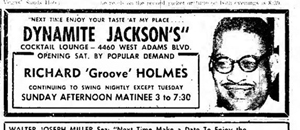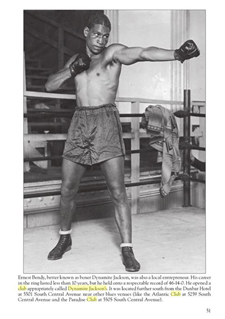Black History Month - All That Jazz
- Details
- Category: Our History
- Published on Monday, 13 February 2017 13:49
- Written by Laura Meyers
Yet even during the Central Avenue’s heyday, many musicians lived in what was then commonly referred to as “West Los Angeles.” Jazz luminaries Eric Dolphy, Vi Redd, Hampton Hawes, and Herb Geller all attended, for example, Dorsey High School.
And by the mid-1940s, as Jim Crow restrictions began to loosen their grip, there was also a burgeoning music scene on the “Westside,” centered on Western Avenue from Pico to Santa Barbara (now Martin Luther King Boulevard), and west from there on Washington, Adams and Jefferson. This new nightlife center became home to at least two dozen clubs and cafes – featuring primarily African American musical acts – that flourished to the early 1960s (and some through the 1970s), but which are now a distant memory.
“When we left Central Avenue, we went straight to Western Avenue. That became the hub,” recounted jazz trumpeter Clora Bryant in an oral history interview documenting Los Angeles’s black music heritage.
The fledgling music scene’s future was cemented by the 1945 opening of a new Westside hotel catering to an African American clientele. “This guy Bill [William] Watkins had come from Chicago, I think he had been a numbers man or something, and he had a lot of money,” Bryant recalled. Watkins purchased a beautiful 1920s apartment building at 2022 West Adams Blvd., a block west of Western, and converted it into the 270-room Hotel Watkins. “It was the first black-owned hotel on the Westside. That hotel [soon] was where all the entertainers stayed.”
In 1952, Watkins opened the Rubaiyat Room in the hotel. It was designed by Norma Harvey, Paul Williams’ daughter, and featured artists from “Babs” Gonzales and jazz/bebop alto saxophonist Sonny Criss to Lou Rawls. Marv Jenkins (Della Reese’s longtime piano man) recorded his 1961 release, Good Little Man, at the Rubaiyat Room. Famed musicians like Duke Ellington, Ray Nance, blues legend Eddie Vinson, and Ella Fitzgerald were among the performers, and Ellington wrote the jazz classic Satin Doll within these walls.
Jazz drummer Roy Porter, in his autobiography There and Back, described the music scene in West Adams and Mid-City. "There were a handful of clubs in the late 1960s that were trying to keep the black jazz tradition alive in Los Angeles. You could always hear good sounds at places like...the Town Tavern at 36th Place and Western, the Watkins Hotel (Rubaiyat Room) at Adams and Western, the Hillcrest Club (which became the Black Orchid) on Washington and Vineyard and John McClain's It Club….I can't overlook the California Club on Santa Barbara [now Martin Luther King Boulevard] near Western, where I played many times. A few years later Max Roach and Clifford Brown made some great music there."
Porter added: "Another joint was Strip City. This was a swinging club with jazz music and strippers. Located at Western and Pico, it was where I first heard (somewhat later) Ramsey Lewis and his trio of Holt and Young on drums and bass.” The same venue at 1304 South Western later became the Basin Street West club, owned by basketball great Wilt Chamberlain.
Porter described another popular place on Western near Exposition that “used to be the old Waikiki Club in the early 1940s on through the 1950s and 1960s. It was called Mike's Waikiki Club, but Mike was a diehard racist who would not admit black people. His club was decorated with coconuts and palm trees inside. He had a Hawaiian bell hung up over the bar so he could ring it for every drink sold. Finally he gave the club up and it became the Tiki Club."
There were a host of other hot spots for jazz, blues, and R&B fans. Many of these clubs were owned by musicians themselves, or other celebrities.
Comedian Redd Foxx owned club Jazz Go-Go close to the corner of Western and Adams, at 1952 West Adams Blvd. The club presented burlesque acts along with top names in comedy and jazz.
Jazz alto saxophonist Earl Bostic, a pioneer of the post-war American rhythm and blues style and an important influence on John Coltrane, opened the R&B club Flying Fox at 3724 West Santa Barbara. [now Western] Sam Cooke was a regular at the nearby California Club.
Politician and music impresario Eddie Atkinson owned the Town Tavern at 3651 S. Western. Two blocks away was the exotic Middle Eastern-themed Oasis Club and Camel Room, at 3801 S. Western. Here fans could hear Charlie Parker, John Coltrane, Dizzy Gillespie, Dexter Gordon, and Chico Hamilton, among many artists, wail the night away.
A stretch of Washington Boulevard from Western to La Brea offered multiple venues. The Ringside Club, at 2182 West Washington, featured Marvin Johnson and His Blue Rhythm Boys. Tommy Tucker’s Play Room at 4907 West Washington was a popular joint.
John McClain, a somewhat notorious Los Angeles figure who rubbed shoulders with gangster Benjamin "Bugsy" Siegel, supported the city's jazz scene by opening the famous It Club, where such artists as Miles Davis and John Coltrane often appeared. In 1964, Thelonius Monk recorded the well-received Live at the It Club album at the establishment, which was located at 4731 West Washington Blvd., across from today’s Nate Holden Theater.
A stretch of Washington Boulevard from Western to La Brea offered multiple venues. The Ringside Club, at 2182 West Washington, featured Marvin Johnson and His Blue Rhythm Boys. Tommy Tucker’s Play Room at 4907 West Washington was a popular joint.
John McClain, a somewhat notorious Los Angeles figure who rubbed shoulders with gangster Benjamin "Bugsy" Siegel, supported the city's jazz scene by opening the famous It Club, where such artists as Miles Davis and John Coltrane often appeared. In 1964, Thelonius Monk recorded the well-received Live at the It Club album at the establishment, which was located at 4731 West Washington Blvd., across from today’s Nate Holden Theater.
“Another place where you could see everybody from Dizzy to Brother Jack McDuff was the Parisian Room at Washington and La Brea," jazz drummer Porter noted in his autobiography. Other regulars included Nancy Wilson, Esther Phillips, Jimmy Witherspoon, Harry "Sweets" Edison, Eddie "Lockjaw" Davis, and Ernie Andrews. Ella Fitzgerald’s name appeared on its big pink neon marquee. Red Holloway was the talent coordinator and member of the house band at the Parisian Room, and he booked a veritable Who’s Who of jazz and blues artists from the late 1960s for the next 15 years, until the place on top of the hill closed to make way for the post office.
 Also on Adams, a little farther west, were the Intermission Room (at 4370) and, at 4456 West Adams, Dynamite Jackson’s cocktail lounge, “swinging nightly”
Also on Adams, a little farther west, were the Intermission Room (at 4370) and, at 4456 West Adams, Dynamite Jackson’s cocktail lounge, “swinging nightly”  and owned by boxer Ernest “Dynamite Jackson” Bendy.
and owned by boxer Ernest “Dynamite Jackson” Bendy.
 Also on Adams, a little farther west, were the Intermission Room (at 4370) and, at 4456 West Adams, Dynamite Jackson’s cocktail lounge, “swinging nightly”
Also on Adams, a little farther west, were the Intermission Room (at 4370) and, at 4456 West Adams, Dynamite Jackson’s cocktail lounge, “swinging nightly”  and owned by boxer Ernest “Dynamite Jackson” Bendy.
and owned by boxer Ernest “Dynamite Jackson” Bendy.Unfortunately, none of these venues for well-loved jazz, blues or R&B remain – and many of the buildings that housed the clubs, such as the Parisian Room, have been erased as well. But the soulful sounds of L.A.’s blues, of jazz, of bebop, of R&B that played within their walls are still alive, influencing todays artists providing a musical background to our rich history.
Categories
-
Architecture
IF ONLY WALLS COULD SPEAK!
 People often think of history as an impersonal collection of facts and dates, a dusty inventory...
People often think of history as an impersonal collection of facts and dates, a dusty inventory...
-
Our History
BRIDGET "BIDDY' MASON: Founder of the First African American Methodist Church FAME
 Originally posted on blackdoctor.orgWhen we talk about Black History, we hear a lot of names over...
Originally posted on blackdoctor.orgWhen we talk about Black History, we hear a lot of names over...
-
In Memory Of
Barbara Morrison Celebrated Jazz Singer Dies at 72
 Barbara Morrison, a legendary singer in the Los Angeles jazz and blues music community, has died....
Barbara Morrison, a legendary singer in the Los Angeles jazz and blues music community, has died....
Today4
Yesterday9
Week41
Month104
All988432
Kubik-Rubik Joomla! Extensions
Yesterday9
Week41
Month104
All988432
Currently are 29 guests and no members online
Kubik-Rubik Joomla! Extensions




